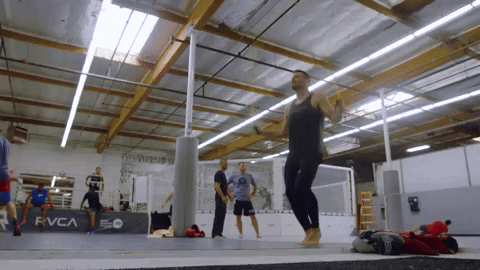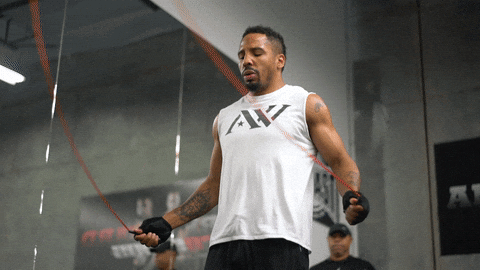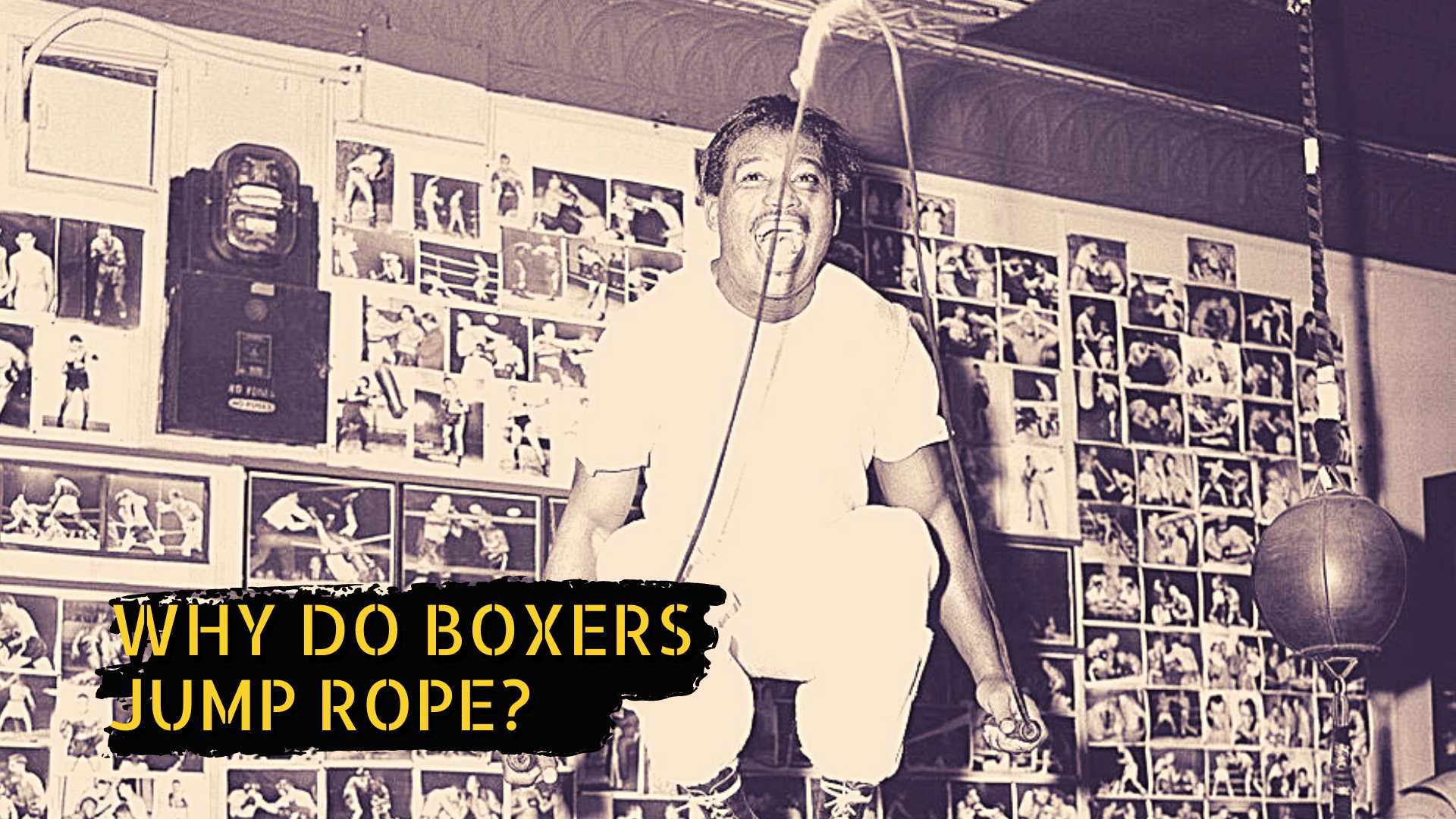If you haven’t watched champion boxers like Mayweather, Tyson or Ali jump rope then you’re missing out. The speed and the agility is just mesmerizing.
But why is jumping rope such a common training exercise for boxers of all levels? Yes, there’s a lot more to it than reminding them of their days in the school playground.
Jumping rope is much-used workout for boxers to improve their cardiovascular functions, develop their footwork, enhance focus and coordination, train explosiveness, and as a warm-up / cool-down exercise.
Why do boxers jump rope? 🪢
1. Cardiovascular training
Extremely high cardio fitness levels are absolutely key for boxers to maintain their energy levels throughout a long, grueling fight. Jumping rope is a great way to get the heart rate up and build endurance
This study showed that jumping rope for just 10 minutes is as good a cardiovascular workout as jogging for 30 minutes! And it can be done without leaving home and with minimal damaging impact on your body.
2. Develop footwork
“Float like a butterfly…”. These immortal words from The Greatest, Mohammed Ali, are a nod to the importance of staying light-footed and agile as a boxer moves around the ring.
Jumping rope, especially using the Boxer’s Skip technique (more on that below), trains a boxer to always be on his toes and never flat-footed.
3. Improve focus and coordination
Jumping rope requires your whole body and mind to be in perfect synchronization. If one part of your body is out of rhythm or your concentration lapses for a split second, you’re done.
Relentless focus and full-body coordination are must haves for a successful boxer, and this study proves the benefits of jumping rope in these respects.
4. Train explosiveness
The best boxers are able to instantly unleash huge quantities of energy and power to blitz their opponent. In other words, they’re explosive.
Basic rope jumping may not look explosive but once you start getting into the double-unders and Tyson squats (keep reading!) you’ll realize that it certainly can be.
5. Warm-up / cool down
Before moving into the high intensity exercises that often come with boxing training, jumping rope is a great way to get the blood flowing and the body into a rhythm.
At the end of a training session, it also acts as a gradual way to reset the heard rate after high intensity boxing training.
Related articles:
- Why do boxers spit out water? (5 reasons)
- What is shadow boxing?
- Why do boxers hug? (Clinching explained)
How should I jump rope? 🙋
Basic fundamentals
No rocket science here:
- Elbows tucked in
- Movement controlled by wrists and forearms
- Feet only come a few centimeters/inches off the ground
- Knees slightly bent
Techniques
Jumping rope can get a lot more complicated than just hopping up and down. If you’re new to it then I’d suggest you start simple: two footed jump over the rope every time it comes round. You can slow things down as much as you need to get comfortable.
Once you’ve mastered that (it shouldn’t take long), you can start to try out some more advanced techniques. With all things, the best way to learn is to start trying and failing until it clicks!
There’s no end to the different ways you can jump rope but, in increasing order of difficulty, here are some techniques for you to try out:
1. Boxer’s skip

This involves transferring your weight from one foot to the other with each jump. Every time you jump, you are on the ball of your foot of your jumping foot, while you tap the floor with the toes of the other foot. It sounds a bit confusing but you’ll get the hang of it.
This technique is great as you can keep going for long periods of time (it’s less strenuous than the standard two-foot jump) without lots of impact on your body. It’s also great footwork training and helps the boxer practice being light footed and spring with his movements.
2. Side swipe

This move is really all about looking smooth! I don’t think it really adds any extra physical strain but worth adding to your repertoire.
The key thing to remember here is that you keep the same hand on top as you swipe back and forward. Start by practicing this without and jumping at all and it will quickly become clear how to do it.
3. Criss cross

Ok, now we’re getting into fancy territory.
The criss cross is where you bring your hands across the front of your body so that your arms are crossed as the rope moves under your feet.
A good way to think about this movement is, like a cowboy, holstering two revolvers, and then removing them again. It’s a figure of 8 movement with your hands.
4. Double under

Remember what I said earlier about explosiveness? This is where it start’s coming into play.
The theory is simple but in practice it is quite hard. It involves the rope coming under your feet TWICE when you jump. Key points here are that you need to jump higher than usual and swing the rope hard for the first under (the momentum will carry it around for the second under).
Start by trying this once every 3 or 5 jumps and eventually you’ll be able to do multiple double-unders consecutively. (Or even triple-unders!)
5. Tyson Squat Jump
Boss level. As the name suggests, here you are doing squats while you jump rope. It’s called the Tyson Squat jump as the legendary Mike Tyson was an absolute beast at this. Sadly couldn’t find any GIFs of this but you’ll see it in the video below (35 seconds in):
FAQs ❓
How often should I jump rope?
As much as you can. But listen to your body and don’t overdo it. You need rest to prevent injury and give your body time to recover.
The beauty of jumping rope is that it can be done with very little space and you can get a good workout in as little as 10 minutes.
How long should I jump rope?
It is recommended to jump rope for at least 10-15 minutes at a time, gradually increasing the duration as you become more comfortable with the exercise.
Is jumping rope hard on the knees?
Jumping rope is a low-impact exercise that is easy on the knees and joints. However, it is important to wear supportive shoes and jump on a shock-absorbing surface to reduce the risk of injury.
What jumping rope should I buy?
Length – Ideally the length of your jump rope should be your height plus 3 feet (90 centimeters)
Brand – you can’t go too far wrong here. No need to spend a fortune on something fancy. Honestly, any rope from a sports shop will do the job. If you want to splash out a bit then Crossrope and BeMaxx make some durable, sleek ropes.
12th Round 🔔
Jumping rope is a staple of boxing training that brings multiple benefits, including:
- Cardiovascular exercise
- Footwork training
- Improve focus and footwork
- Explosiveness training
- Warm-up / cool down
So, get yourself a rope and start practicing. Take it easy at first but before long you’ll be skipping like Tyson.
Happy fighting! 🥊🥊
“That man was beautiful. Timing, speed, reflexes, rhythm, his body, everything was beautiful. And to me, still, I would say pound for pound…I’d say I’m the greatest heavyweight of all time, but pound for pound, I still say Sugar Ray Robinson was the greatest of all time.” – Muhammad Ali


